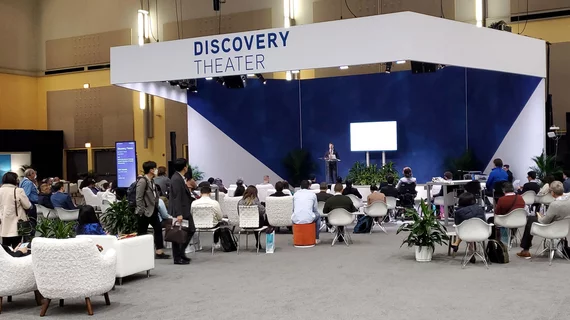Last fall Yale Radiology began offering users of its EHR-based patient portal a link to a page on RadiologyInfo.org headed “How to read your radiology report.” The page drew 400 or so clicks in its first two weeks. Today it’s getting 5,000 to 10,000 a month.
At an RSNA 2022 session in Chicago Nov. 30, a reviewer of the page’s content, Yale’s Jay Pahade, MD, told attendees he’d been pleasantly shocked by the response.
“At first I was thinking, ‘Oh, let’s put this up there and see what happens,” Pahade said. “And now I’m blown away” to see such widespread hunger for basic information about radiology—not to mention for step-by-step, radiologist-vetted descriptions of specific imaging procedures.
Joining Pahade at the podium was Arun Krishnaraj, MD, MPH, of UVA Health, who chairs the ACR’s Commission on Patient- and Family-Centered Care and lead-authored the primer on reading radiology reports.
The site, which is co-sponsored by RSNA and the American College of Radiology, draws an overall 1.5 million to 2 million pageviews per month.
(In fact, the average per-month click count topped 2.5 million before Google changed its search algorithms during the COVID-10 pandemic, the speakers noted.)
Krishnaraj defined RadiologyInfo.org’s purpose as “to take away the mystery and scariness of our machines and give patients an opportunity to engage with and understand what it is about radiology and radiology care that impacts their outcomes.”
Ultimately, he added, if the specialty is to help U.S. healthcare move the proverbial needle toward the aim of shared decision-making, “we have to empower patients with relevant and accurate information.”
Relevant Results Make for Primed Patients
Pahade cited recent research showing 20% of patients report receiving no information on their respective imaging exams prior to arriving for the procedure. About 50% are self-informed, many having Googled for insights and made do with whatever results appear.
Equally vexing is the general search engine’s proclivity for mixing hits that span the continuum from the spot-on to the completely irrelevant.
Practices and departments that embed RadiologyInfo.org links within patient portals can head off this source of consumer frustration and misinformation, Pahade said.
“If you’re scheduled for breast tomosynthesis, we [at Yale] have made it so that you get a RadiologyInfo.org link on that particular procedure,” he said. “You don’t need them to get generic information about breast biopsy. You want to give them the relevant information for their exam type. That’s really key.”
Asked by Radiology Business to clarify the upside of RadiologyInfo.org for providers, Pahade responded:
“More prepared and engaged patients have more successful exams and are less likely to cancel appointments [due to anxiety]. So it’s a win for radiology practices and their referrers.”
Patient-Centric Perspective
Underscoring that RadiologyInfo.org is a perpetual work in progress—its pages are updated as needed—Pahade said expanded video content is probably in the site’s future.
“What we’re thinking about right now is: How do we better explain the radiology report to patients? Some of the content that we’re going to start to develop is video content that’s even more geared to [unpacking] commonly performed radiology exams.”
Down the line, he continued, watch for RadiologyInfo.org to move closer toward interpreting radiology reports in lay language.
“We’re still some time away from that,” Pahade said. “But that will probably happen and, until it does, patients will continue reading their radiology reports on patient portals.”
For now RadiologyInfo.org’s primary task is to help prepare patients before and after their imaging procedures. On the front end, Pahade points out, that can include offering portal links to things like driving directions and parking tips.
Combining the website’s globally relevant content with such locally pertinent particulars is “incredibly powerful and actually incredibly easy to do,” Pahade said.
At RadiologyInfo.org, he added, “the resources are designed for patients, and the content is constantly expanded. You have multiple methods to help you better integrate the site into your practice to feed information to patients that they want to know.”
A news item posted in the ACR Bulletin last fall ties RadiologyInfo.org’s recent growth spurts to the 21st Century Cares Act.

